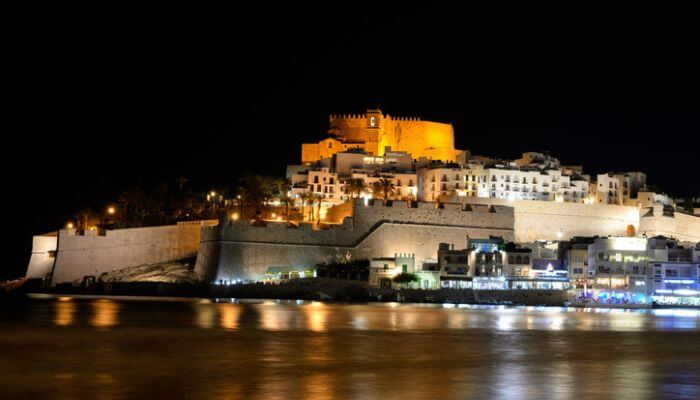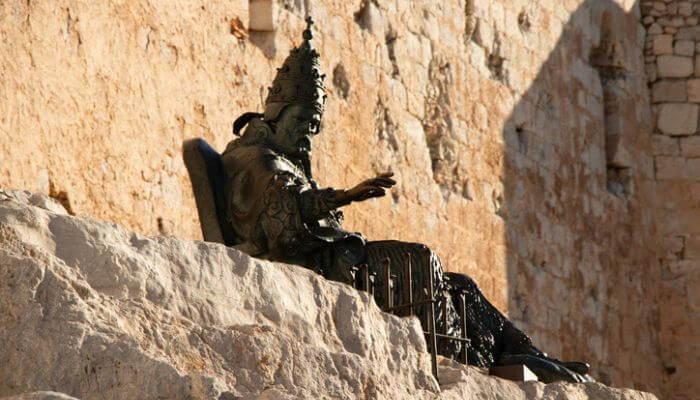Haven't visited Peñíscola Castle yet?
Peñíscola Castle is one of the most memorable heritage attractions in the Valencian Community. It not only forms a beautiful profile in one of the most pleasant seaside towns in Castellón, but also guarantees a wonderful historical experience.
Peñíscola Castle, a magnet for visitors
This castle in Peñíscola is the town’s biggest tourist attraction and the epicenter of a lively commercial and social scene.
In fact, on the surrounding ramps that allow access to the fortification, you’ll find a spectacular medieval-style market. In addition, the viewpoints, restaurants, terraces, and flow of visitors bring life and maximum animation to the area, especially after sunset.
It is located on the highest point of the characteristic rock that dominates this city. Its official name is Templar-Pontifical Castle of Peñíscola, but it is popularly known as the Castle of Pope Luna, as it was the seat of the most famous Spanish Pope in history, the controversial Benedict XIII.
With a maximum height of 64 meters, an average of 20, and a perimeter of 230 meters, it is a Romanesque work built on an old Arab citadel.

The history of Peñíscola Castle
In Andalusian times, there was a fortress in this location used for border control. In 1233, the conquest by James I of Aragon changed the established order, and a century later, the Templars settled in it. The Templar occupation took place between 1294 and 1307.
The new fortress was built with Romanesque schemes and principles, very similar to the patterns of the Templar castles. When they were evicted, it was completely abandoned until, in the 15th century, Pope Luna turned it into his home.
Who was Pope Luna?
Pedro Martínez de Luna y Pérez de Gotor was an Aragonese who put the entire Catholic Church in check. His election as Pope was full of controversy and serious difficulties for this institution.
In fact, in the context of the so-called Western Schism, three different popes coincided. One of them, the most persevering and alternative, was Benedict XIII.
In 1417, the aforementioned schism culminated with the election of a single pope, based in Rome. Pope Luna had been elected in Avignon, under French support. He was deposed, excommunicated, and declared an antipope. Then, he took refuge in this construction. From that moment on, this fortification became known as the Castle of Pope Luna in Peñíscola.
This heir of Saint Peter turned it into his pontifical seat and never resigned from his position, despite having only the support of the Crown of Aragon. He died in 1423 and, even today, some legends claim that he still dwells, in spirit, in this fortress.

Later, Gil Sánchez Muñoz, also from Aragon, became the second Pope of Peñíscola, under the name of Clement VIII. He occupied this building until his influence waned, and with it, that of this line of alternative papacy.
Outstanding architectural features
Similar to the castle of Miravet, which was built a century and a half earlier, this castle that became a papal palace has very attractive technical characteristics.
Its main feature is constructive sobriety and solidity. The carved stone walls, the barrel vaults, and the large voussoir arches are its most defining features.
The greatest charms of this construction are the vaulted solution of the Guard Corps and the imposing Basilica of the Templars. It stands out for the presbytery with a semicircular apse and a half-dome shell. In it, for some years, remained the mortal remains of Pope Luna.
Opening hours of the Castle of Pope Luna in Peñíscola
We recommend that you check the opening hours of Peñíscola Castle on the official website of this heritage jewel. You should know, in any case, that there are two possibilities:
- Winter season. From October 16 to Palm Sunday, from 10:30 AM to 5:30 PM.
- Summer season. From Palm Sunday to October 15, from 9:30 AM to 9:30 PM.
Visits are made during practically the whole year. It is only closed five days a year, which you can check on the mentioned website.
This castle in Peñíscola is one of the great heritage and historical treasures of Spain. And also, a charming, beautiful, attractive, and mysterious destination. Strolling through its surroundings, appreciating the Mediterranean Sea from its walls, and buying handicrafts in its vicinity is a real treat. It is an excellent plan for all types of audiences, families with children who are fond of culture, couples in love, groups of friends, etc.
Come and discover Peñíscola!
The Peñíscola Castle is not the only attraction of this town, whose beaches, gastronomy, shops, services, and nightlife are formidable. Choose the best accommodation in Peñíscola and enjoy all its charms!


